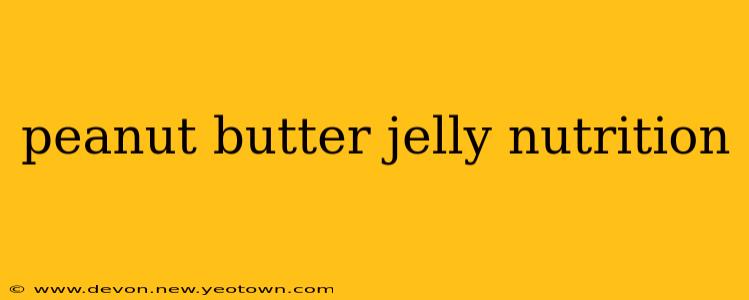Ah, the peanut butter and jelly sandwich. A childhood staple, a lunchtime classic, a comfort food for all ages. But beyond its delicious simplicity, have you ever considered the nutritional powerhouse hidden within those two seemingly humble ingredients? Let's unpack the surprisingly wholesome profile of this beloved pairing.
What are the nutritional benefits of peanut butter?
Peanut butter is more than just a creamy, dreamy spread. It's packed with protein, healthy fats, and essential vitamins and minerals. The protein content helps keep you feeling full and satisfied, making it a great addition to a balanced diet. Those healthy fats are mostly monounsaturated and polyunsaturated, which are beneficial for heart health. Plus, you'll find a good dose of vitamin E, magnesium, and potassium within each spoonful. It's a fantastic source of sustained energy, making it ideal for fueling active lifestyles.
What are the nutritional benefits of jelly?
While often seen as the "lesser" half of the duo, jelly also contributes to the nutritional profile of the classic sandwich. Of course, the nutritional value varies significantly depending on the type of jelly. Fruit-based jellies, particularly those with minimal added sugar, offer a source of vitamins and antioxidants derived from the fruit itself. Look for jellies with whole fruit pieces and lower sugar content for a healthier choice. Many jellies contain Vitamin C, a potent antioxidant. However, it's crucial to be mindful of added sugars, as many commercial jellies are high in them.
How many calories are in a peanut butter and jelly sandwich?
The calorie count of your PB&J depends heavily on the ingredients and portion sizes. A typical sandwich made with two slices of white bread, two tablespoons of peanut butter, and one tablespoon of jelly can range from 250 to 400 calories. Opting for whole-wheat bread, reducing the amount of peanut butter or jelly, or choosing a lower-sugar jelly will help reduce the overall calorie count.
Is peanut butter and jelly healthy for weight loss?
Peanut butter and jelly can certainly be part of a weight-loss diet, but moderation is key. The combination provides protein and fiber which can help you feel full and satisfied, potentially reducing overall calorie intake throughout the day. However, the high calorie and sugar content in some versions can hinder weight loss efforts if consumed in excess. Choosing whole-wheat bread, reducing portion sizes, and opting for lower-sugar jellies are vital for maintaining a healthy weight.
What are the health risks of eating too much peanut butter and jelly?
While generally a healthy choice, overindulging in peanut butter and jelly can lead to several potential health issues. Excessive consumption of added sugars in many commercial jellies can contribute to weight gain, type 2 diabetes, and other metabolic problems. Peanut butter, while nutritious, is also high in calories and fat; consuming too much can lead to unwanted weight gain. Furthermore, some individuals may have allergies to peanuts or specific ingredients within the jelly. Always be mindful of portion control and potential allergies.
What are some healthier alternatives to peanut butter and jelly?
There are many delicious and nutritious variations on the classic PB&J theme. Consider swapping white bread for whole-wheat or even multigrain bread for increased fiber. Experiment with different types of nut butters, such as almond butter or cashew butter, for varied nutritional benefits and flavor profiles. You can also use alternatives to traditional jelly, such as mashed bananas, applesauce, or even a thin layer of honey for natural sweetness.
In conclusion, the peanut butter and jelly sandwich, when prepared mindfully, can be a surprisingly nutritious and satisfying meal or snack. By being aware of portion sizes, choosing whole-grain options, selecting low-sugar jellies, and understanding the nutritional profile of each ingredient, you can enjoy this classic combination while prioritizing your health and wellbeing.

